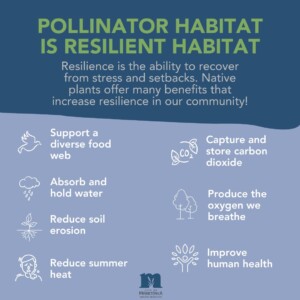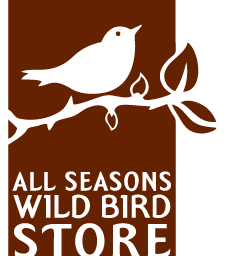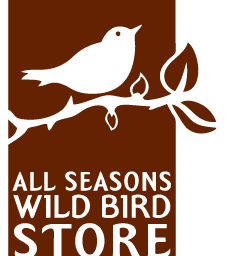
Are you working to create a bird-friendly yard? Don’t forget about the pollinators!
A pollinator is any animal that visits flowers in search of nutritious pollen or energy-filled nectar and, as it travels, moves pollen between plants. Hummingbirds, bees and butterflies are well-known pollinators—but they’re not alone. Here in Minnesota, many kinds of wasps, flies, moths, beetles and other insects also provide this essential ecological service. Pollination helps plants reproduce, resulting in fruits and seeds that feed a bounty of birds.
It Goes Both Ways
Adult pollinators use flowers as food, but they frequently need plants at other life stages as well. Moths and butterflies especially depend on leaves as a built-in food source for their caterpillars, and may require very specific plants or plant groups for this purpose.
That’s a real boon for birds. Have you watched summer songbirds flit continuously between different plants and their nest sites? They are plucking juicy caterpillars and other insects from the leaves, because each nestling may need hundreds of these high-protein meals before it fledges.
Relationships Matter
In each region of Minnesota, North America and the world, plants, pollinators and birds have evolved in lockstep. Over vast stretches of time, they have formed mutually beneficial relationships. The result? Each of our native plant species supports and depends on many local animal partners. Ornamental plants from other parts of the world can provide beauty in our yards and some environmental benefits, such as carbon capture or erosion control. But they can’t match the impact of native trees, shrubs, wildflowers and grasses.
At Risk
Despite their diversity, pollinators are in decline everywhere.
• One challenge is human land use, which alters habitat where they feed, nest, migrate or overwinter. Pesticides often harm pollinators as well as the pests they target.
• Exterior lights can be harmful to moths and other night-flying pollinators as well as birds.
• Climate change is shifting the distribution of some plants and the timing of flowering. It also increases the frequency of drought, heat and other environmental stressors.
The Good News
Together, we can all take steps to protect, create and preserve habitat. Toward this goal, in 2017 the City of Minnetonka joined the Mayors’ Monarch Pledge program from the National Wildlife Federation. This robust pledge provides a framework and 29 broad-action steps that help cities communicate and plan across departments, identifying pollinator-beneficial strategies in a wide range of municipal efforts—from weed control and habitat restoration to development, park planning and recreation. Minnetonka is proud to be a national leader in this effort. But the work isn’t done! Minnetonka and other cities will need to continue taking bold steps and trying new approaches to help natural and human communities adapt to a changing environment.
 Your Yard is Habitat
Your Yard is Habitat
In many cities, a large proportion of natural areas are found on private property. That makes it especially important for cities to inform, inspire and empower residents to take actions benefitting pollinators in their own yards. The message is simple: Whether you have a large yard or a small balcony, your property can provide healthy, diverse habitat!
Join us to celebrate pollinators!
July is Monarch and Pollinator Awareness Month in Minnetonka. Whether you live here or elsewhere, join us to learn more, enjoy fun activities, and take the Polli-Neighbor Pledge. Learn more at:
minnetonkamatters.com/pollinator-month.
 CHRISTINE PETERSEN is the Natural Resources Engagement Coordinator for the City of Minnetonka. You can reach her at
CHRISTINE PETERSEN is the Natural Resources Engagement Coordinator for the City of Minnetonka. You can reach her at
cpetersen@minnetonkamn.gov to learn more, or invite staff from your city to connect about pollinator efforts.

